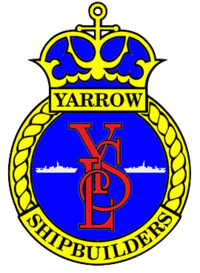Yarrow Shipbuilders Limited
 |
|
| Public company | |
| Industry | Shipbuilding |
| Fate | Merged with others to form British Shipbuilders (1977–1985) |
| Successor |
GEC Marconi Marine (YSL) (1985–1999) BAE Systems Marine (1999–2003) BAE Systems Naval Ships (2003–2006) BAE Systems Surface Fleet Solutions (2006–2008) BVT Surface Fleet (2008–2009) BAE Systems Surface Ships (2009–) |
| Founded | 1865 |
| Headquarters | Scotstoun, Glasgow, UK |
|
Key people
|
Sir Alfred Yarrow Sir Harold Yarrow Sir Eric Yarrow Sir Sir Robert Easton Murray Easton CBE |
| Products |
Naval ships Merchant ships Marine steam engines Marine engines Boilers |
|
Number of employees
|
Approximately 3,000 |
| Parent |
Upper Clyde Shipbuilders (1968–1970) Yarrow & Co. Ltd. (1970–1977) British Shipbuilders (1977–1985) GEC Marconi (1985–1999) BAE Systems (1999–) |
| Subsidiaries | Coventry Ordnance Works (1905–1925) |
Yarrow Shipbuilders Limited (YSL), often styled as simply Yarrows, was a major shipbuilding firm based in the Scotstoun district of Glasgow on the River Clyde. It is now part of BAE Systems Surface Ships, owned by BAE Systems, which has also operated the nearby Govan shipyard since 1999.
The company was founded by Alfred Yarrow, later Sir Alfred Yarrow, 1st Baronet, in the year 1865 as Yarrow & Company, Limited. Originally it was based at Folly Wall, Poplar, then in 1898 as the company grew, Yarrow moved his shipyard to London Yard, Cubitt Town. Hundreds of steam launches, lake and river vessels, and eventually the Royal Navy's first destroyers, the Havock class, were built at Yarrow's London shipyards between 1869 and 1908. Yarrow was also a builder of boilers, and a type of water-tube boiler developed and patented by the company was known as the "Yarrow boiler", first used in a torpedo boat in 1887 and later used for a number of applications, from the propulsion plant of RMS Queen Mary to the LNER Class W1 locomotive.
Despite a move of yards, Yarrows outgrew its London site and this and the cost of land and labour in London led to a second move to what was at that time a greenfield site at Scotstoun in the west of Glasgow, beginning in 1906. Between 4,000 and 5,000 tons of material had to be transported, from models to heavy machine tools. A train-load of from forty to fifty wagons left the works at Poplar every day. The first vessel launched from the new works at Scotstoun on 14 July 1908 was the lead ship of the Pará-class destroyers for the Brazilian Navy. The company also established the Coventry Ordnance Works joint venture in 1905, building a large factory near to its Scotstoun Shipyard in 1910. During the First World War, the company developed the pioneering Erskine artificial limb with Sir William Macewen.
...
Wikipedia
